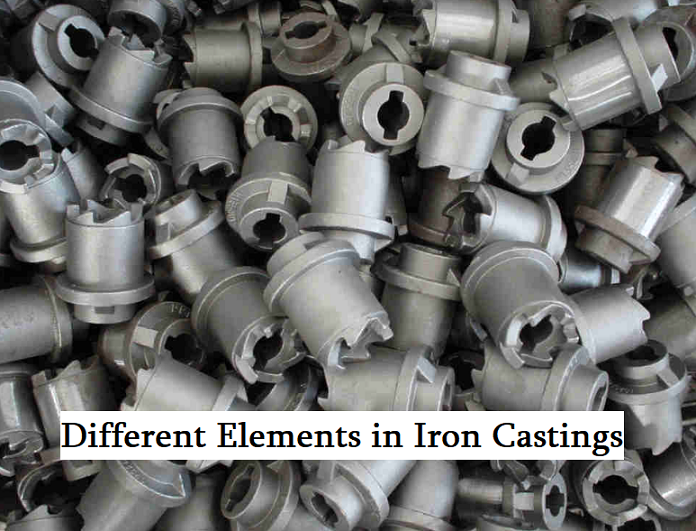The ordinary elements of castings are carbon, silicon, manganese, sulfur and phosphorus, how does each element affect the properties of castings?

Uses and Functions of 5 Different Elements in Iron Castings
Cast iron is actually a very complex chemical process based on carbon, silicon, manganese, sulfur, phosphorus and other elements. Among them, carbon and silicon are the most basic components. When manganese content is generally low, it has little effect. Sulfur and phosphorus are often regarded as impurities. Each element has a certain effect on the quality, solidification crystallization, structure and properties of cast iron.
1. Silicon is an advantageous component in castings. It can encourage graphitization, just as the atom carbon. The impact of silicon added as an inoculant is more noticeable. Increasing the silicon percentage in cast ductile iron castings has dual effects. It reduces cementite, pearlite and ternary phosphorus eutectic, and increases ferrite, thus reducing strength and hardness and improving the plasticity of castings. Silicon solution can strengthen ferrite, which can improve the yield point and hardness. Silicon improves casting fluidity and increases volume expansion during solidification. Silicon can improve heat resistance and corrosion resistance. Increasing the amount of silicon, especially the amount of silicon inoculated, can significantly control the amount of carbides. Therefore, silicon is a strong element that inhibits the white tendency of medium manganese ductile iron. In a certain range, silicon is beneficial to the improvement of strength and toughness, but it decreases the wear resistance. Generally, the silicon content of gray castings is 1.2%-3.0%, and that of ductile castings is 2.0%-3.0%.
2. Carbon is the most basic component in iron castings. It is the main basis for distinguishing steel or iron. Iron with a carbon content of more than 1.7% is called iron, and steel with a carbon content of less than 1.7% is called steel. In addition, during the production process, carbon affects the mechanical properties of castings. In casting, carbon will promote graphitization, reduce the tendency of white mouth, that is, reduce cementite, pearlite, ternary phosphorus eutectic, and increase ferrite, thus reducing hardness and improving processing performance.Carbon promotes magnesium absorption; Improve spheroidization to achieve the desired effect. Carbon can improve the fluidity and increase the volume expansion during solidification; Carbon improves vibration absorption, antifriction and thermal conductivity. However, too high carbon content will cause graphite floating, which will deteriorate the mechanical properties, and too low carbon content will easily cause shrinkage porosity and other defects. For castings with different quality requirements, reasonable selection of carbon content is generally a way to improve the quality of castings. Carbon has no obvious effect on the mechanical properties of medium manganese ductile iron. Generally, when the carbon content is higher than 3.9%, graphite floats easily, which affects the quality of cast iron. When the carbon content is lower than 3.0%, it is not conducive to graphitization, so it is generally appropriate to control the carbon content between 3.0% and 3.8%.
3. Manganese is one of the important elements in castings. Proper amount of manganese can help to generate texture structure, and increase robustness, strength and wear resistance. Manganese, like sulfur, is a stable compound and an element that hinders graphitization. When it coexists with sulfur, manganese and sulfur have a greater affinity and will combine into compounds such as MnS. At an appropriate temperature, it not only has no hindering graphitization, but also neutralizes sulfur and plays a role in sulfur removal. When manganese reaches a certain amount, it can make the castings have the advantages of high strength, high hardness, high density, wear resistance, etc. At this time, the silicon content is also correspondingly increased. Manganese tends to segregate at the boundary of eutectic cluster, and carbide is easy to form in the as cast state. Increasing the amount of manganese will deteriorate the mechanical properties. Therefore, the content of manganese should generally be low. However, manganese can stabilize austenite and promote the formation of austenite matrix, which can become weak magnetic ductile iron with good wear resistance. Manganese is a solid solution in austenite and forms a replacement solid solution with iron. Moreover, because manganese has a stronger affinity for carbon than iron, it organizes carbon diffusion and precipitation from the solid solution and plays a role in stabilizing and expanding the austenite region.
4. Sulfur is also an impurity and a harmful element. In casting, sulfur has strong affinity with Mn, Mg and other elements, produces stable carbides, hinders graphitization, consumes spheroidizing elements in molten iron, and forms MgS, MnS and other residues. Due to the consumption of sulfur, if the content of effective residual spheroidizing elements is too low, spheroidization will be reduced, and the formation of slag inclusions, subcutaneous pores and other defects will also be promoted. The mechanical properties are reduced or unstable due to the reduction of nodularization rate by sulfur, acceleration of nodularization recession and formation of slag inclusion. Sulfur should be removed, and the content should be low. In ordinary gray iron, the sulfur content is generally 0.02%~0.15%, and in ductile iron, S ≤ 0.02%, sometimes depending on the situation.
5. Phosphorus is a harmful element and is treated as an impurity. Phosphorus often affects the mechanical properties of castings, especially reduces the toughness and density, and is the main reason for the cracking of castings. Because the solubility of phosphorus in castings is very low. For example, when P<0.05%, the solution is in iron, which has no obvious adverse effect on the mechanical properties of nodular cast iron. Phosphorus is an element easy to segregate in cast iron. When the phosphorus content in the casting reaches 0.05%, it is possible to form phosphorus eutectic. For most castings, phosphorus eutectic will increase the brittleness of the casting and seriously deteriorate the mechanical properties. The phosphorus content should be limited to 0.04%. But phosphorus can improve the hardness and wear resistance. In some wear-resistant cast iron, phosphorus should be added to make use of the wear resistance of phosphorus eutectic.

